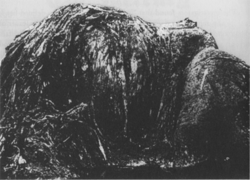New Zealand Globster
A whale carcass, initially unidentified due to decomposition, was found washed ashore at Muriwai Beach, 42 kilometres from the centre of Auckland in New Zealand, in March 1965. At some point in time it was dubbed a "globster", after the Tasmanian Globster, a whale carcass found in Australia a few years earlier.
Contemporary reports

The Auckland Star reported the find on its front page of 23 March 1965. At that time the carcass was 20 ft (6.1 m) long. It had a tough 1/4 inch thick hide, under which was a thin layer of what appeared to be fat, then solid meat. It was covered in what appeared to be "sand-matted grey hair four to six inches long". A Marine Department officer who had seen it more than a week earlier, said it had then been 30 ft (9.1 m) long by about 8 ft (2.4 m). The carcass was 15 miles from the southern end of the beach, and the article included two photographs of it. Shown photographs, John Morton, head of the zoology department at the University of Auckland, said, "You can rule out whales because of the hair, and you can rule out sea elephants and sea cows because of its size. I can't think of anything it resembles." The article said that theories on the object ranged from "a sea monster" to "an unusual elephant which had died at sea", without indicating who raised these theories.[1]
The following day, 24 March 1965, the Auckland Star reported that "Laboratory tests by Auckland University zoology specialists on parts of the 'hairy' mass washed up on Muriwai Beach today identified it as the 'very decomposed' remains of a whale." Senior students had visited the carcass the previous evening and cut a sizeable chunk from it. "Senior zoology lecturer Miss J. Robb said today the skin and most of the blubber had been scoured or eaten off the huge mound of flesh, leaving a fibrous tissue which had been so uniformly shredded it looked like hair. 'We are positive of our identification,' said Miss Robb. 'It is a very dead, very smelly whale.'" Neither article in the Auckland Star mentioned the term "globster".[2]
Later discussion
The September 1968 issue of Pursuit: Journal of the Society for the Investigation of the Unexplained had an article titled "More Globsters", which covered the Tasmanian Globster (for which the term "globster" was coined), the Muriwai carcass, and several similar cases in Australia and the United States. It incorrectly identified Muriwai Beach as being "on the East Cape of North Island" (the settlement of Muriwai on the East Cape is several hundred miles from Auckland and the nearby beach is less than 15 miles long).[3] The January 1969 issue of Pursuit criticised the "expert" (unnamed, but implied as John Morton) who was "reported" to have said it was perhaps "an unusual elephant" (even though the Auckland Star did not attribute this to Morton), then noted that the "expert" finally said it was a decomposed whale.[4]
Marine biologist Richard Ellis's 1994 book Monsters of the Sea mentioned the "New Zealand globster", noting that "Greenwell (1988) reproduced a couple of photographs of the New Zealand globster, but they are without specific identification or credit".[5] Ellis himself reproduced one of the photographs, with the credit saying "Photo courtesy of Richard Greenwell and Sidney K. Pierce".[6] The photograph is one of the two published in the Auckland Star on 23 March 1965.
The New Zealand globster was also mentioned by cryptozoologist George Eberhart in his 2002 book Mysterious Creatures: A Guide to Cryptozoology.[7]
References
- ↑ "What is it ...?". Auckland Star. 23 March 1965. p. 1.
- ↑ "'Whale' of a mystery is solved". Auckland Star. 24 March 1965. p. 1.
- ↑ "More Globsters". Pursuit: Journal of the Society for the Investigation of the Unexplained. 1 (4): 16–17. 30 September 1968. Retrieved 10 November 2015.
- ↑ "Editorial". Pursuit: Journal of the Society for the Investigation of the Unexplained. 2 (1): 1–2. January 1969. Retrieved 10 November 2015.
- ↑ Ellis, Richard (1994). Monsters of the Sea. New York: Knopf. pp. 316–17. ISBN 0679406395.
- ↑ Ellis 1994, p. 429.
- ↑ Eberhart, George M. (2002). Mysterious Creatures: A Guide to Cryptozoology. Santa Barbara, California: ABC-CLIO.
Another fibrous Globster was found in March 1965 on Muriwai Beach, North Island, New Zealand. It was 30 feet long, 8 feet high, and covered with hair 4-6 inches long.